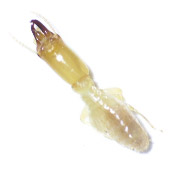|
Termites

Identification
The termites are a group of social insects usually classified at the taxonomic rank of order Isoptera. As truly social animals, they are termed eusocial along with the ants and some bees and wasps which are all placed in the separate order Hymenoptera. Termites mostly feed on dead plant material, generally in the form of wood, leaf litter, soil, or animal dung, and about 10% of the estimated 4,000 species (about 2,600 taxonomically known) are economically significant as pests that can cause serious structural damage to buildings, crops or plantation forests. Termites are major detrivores, particularly in the subtropical and tropical regions, and their recycling of wood and other plant matter is of considerable ecological importance.
Habitat
Termites usually avoid exposure to unfavourable environmental conditions. They tend to remain hidden in tunnels in earth and wood. Where they need to cross an impervious or unfavourable substrate, they cover their tracks with tubing made of faeces, plant matter, and soil. Sometimes these shelter tubes will extend for many metres, such as up the outside of a tree reaching from the soil to dead branches. Termite barrier systems used for protecting buildings aim to prevent concealed termite access, thus forcing the termites out into the open where they must form clearly visible shelter tubes to gain entry.
Damage
Because of their wood-eating habits, termites sometimes do great damage to unprotected buildings and other wooden structures. Their habit of remaining concealed often results in their presence being undetected until the timbers are severely damaged and exhibit surface changes. Once termites have entered a building, they do not limit themselves to wood; they also damage paper, cloth, carpets, and other cellulosic materials. Often, other soft materials are damaged and may be used for construction. Particles taken from soft plastics, plaster, rubber, and sealants such as silicon rubber and acrylics are often employed in construction.
|